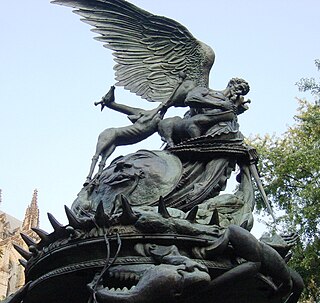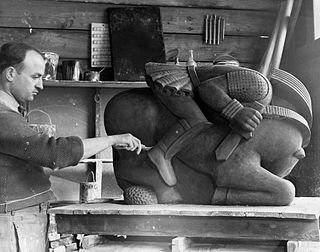
Art Nouveau is an international style of art, architecture, and applied art, especially the decorative arts. It was often inspired by natural forms such as the sinuous curves of plants and flowers. Other characteristics of Art Nouveau were a sense of dynamism and movement, often given by asymmetry or whiplash lines, and the use of modern materials, particularly iron, glass, ceramics and later concrete, to create unusual forms and larger open spaces. It was popular between 1890 and 1910 during the Belle Époque period, and was a reaction against the academicism, eclecticism and historicism of 19th century architecture and decorative art.

A Gesamtkunstwerk is a work of art that makes use of all or many art forms or strives to do so. The term is a German loanword accepted in English as a term in aesthetics.

Hildreth Meière (1892–1961) was an American muralist active in the first half of the twentieth century who is especially known for her Art Deco designs. During her 40-year career she completed approximately 100 commissions. She designed murals for office buildings, churches, government centers, theaters, restaurants, cocktail lounges, ocean liners, and world’s fair pavilions, and she worked in a wide variety of mediums, including paint, ceramic tile, glass and marble mosaic, terracotta, wood, metal, and stained glass. Among her extensive body of work are the iconographic interiors at the Nebraska State Capitol in Lincoln, the dynamic roundels of Dance, Drama, and Song at Radio City Music Hall, the apse and narthex mosaics and stained-glass windows at St. Bartholomew's Episcopal Church (Manhattan), and the decoration of the Great Hall at the National Academy of Sciences in Washington, D.C.

Trencadís, also known as pique assiette, broken tile mosaics, bits and pieces, memoryware, and shardware, is a type of mosaic made from cemented-together tile shards and broken chinaware. Glazed china tends to be preferred, and glass is sometimes mixed in as well, as are other small materials like buttons and shells. Artists working in this form may create random designs, pictorial scenes, geometric patterns, or a hybrid of any of these.
Toshiko Takaezu was an American ceramic artist, painter, sculptor, and educator whose oeuvre spanned a wide range of mediums, including ceramics, weavings, bronzes, and paintings. She is noted for her pioneering work in ceramics and has played an important role in the international revival of interest in the ceramic arts. Takaezu was known for her rounded, closed ceramic forms which broke from traditions of clay as a medium for functional objects. Instead she explored clay's potential for aesthetic expression, taking on Abstract Expressionist concepts in a manner that places her work in the realm of postwar abstractionism. She is of Japanese descent and from Pepeeko, Hawaii.

Greg Wyatt is an American representational sculptor who works primarily in cast bronze, and is the sculptor-in-residence at the Cathedral Church of St. John the Divine in New York City.

The Feltville Historic District, located in the Watchung Reservation in Berkeley Heights, Union County, New Jersey, United States, is a historic area which contains several buildings dating to the 18th century. It is known locally as "Deserted Village."

Waylande Desantis Gregory was one of the most innovative and prolific American art-deco ceramics sculptors of the early 20th century. His groundbreaking techniques enabled him to create monumental ceramic sculpture, such as the Fountain of the Atoms and Light Dispelling Darkness, which had hitherto not been possible. He also developed revolutionary glazing and processing methods, and was a seminal figure in the studio glass movement.

Pamela Irving is an Australian visual artist specialising in bronze, ceramic and mosaic sculptures as well as printmaking and copper etchings. In addition to her extensive art work, Irving has lectured in art and ceramics at Monash University, the Melbourne College of Advanced Education, the Royal Melbourne Institute of Technology (RMIT) and the Chisholm Institute of Technology. She also worked as an art critic for the Geelong Advertiser and was a councillor on the Craft Council of Victoria.

Personnages Oiseaux is one of Joan Miró's largest works in the United States and his only glass mosaic mural. It was created between 1972 and 1978.
Grounds For Sculpture (GFS) is a 42-acre (170,000 m2) sculpture park and museum located in Hamilton, New Jersey. It is located on the former site of Trenton Speedway. Founded in 1992 by John Seward Johnson II, the venue is dedicated to promoting an understanding of and appreciation for contemporary sculpture by organizing exhibitions, publishing catalogues, and offering a variety of educational programs and special community events.
Heather Mae Erickson is an artist, a craftsperson, and a designer. Erickson earned her BFA at The University of the Arts, majoring in crafts specializing in ceramics with a concentration in art education. Continuing her studies at Cranbrook Academy of Art, she earned an MFA in ceramic art.
Enid Bell Palanchian, known professionally as Enid Bell in her early career and later on as Enid Bell Palanchian, was an American sculptor, illustrator and teacher born in London, England.
Barbara Harnack is a ceramic and mixed media sculpture artist. In 2016, she began expanding her career in painting. She has also co-authored a Children's book with husband and sculptor/ writer Michael Lancaster.
The Gregangelo Museum is a work of installation art located in a Mediterranean-style house originally built in the early 1920s in the St. Francis Wood district of San Francisco. The house was converted into an art project during the 1980s. Though most of the twenty-seven rooms in the house have been significantly remodeled, the original 1920s architecture was intentionally salvaged. The founder, Gregangelo Herrera, owns Gregangelo’s Velocity Circus/Arts and Entertainment, a circus troupe and arts and entertainment company which uses the Gregangelo Museum as a company headquarters. The Gregangelo Museum has been cited in interior design books, television networks, and editorial pages such as The Bold Italic and the San Francisco Chronicle. In 2012, The Gregangelo Museum was dubbed one of a few "Home Strange Homes" by HGTV and has since featured on Voltage TV's "World's Weirdest Homes" and Netflix's Amazing Interiors. The Gregangelo Museum was also recently featured in The Mercury News as one of the “12 coolest bay area things you didn’t know you could do” as well as being included in “Secret San Francisco: A Guide to the Weird, the Wonderful, and the Obscure."
Beverley Magennis is a ceramic sculptor who works within the nexus of tile and architectural form.
Nguyễn Thu Thủy is a Vietnamese artist who currently works for the Hanoi New Newspaper. She is the current holder of the Guinness World Records for the Largest Ceramic Mosaic.
Catherine Yarrow was an English artist known for printmaking, painting, ceramics and pottery in a surrealist mode. She studied at the Royal Academy of Dramatic Art, graduating in 1925. The art historian Patricia Allmer has described her as 'one of the international figures of surrealism and its developments in the 1940s.'

Doris Seidler née Falkoff (1912–2010) was an English painter, printmaker and graphic artist.

Fosterfields, also known as Fosterfields Living Historical Farm, is a 213.4-acre (86.4 ha) farm and open-air museum at the junction of Mendham and Kahdena Roads in Morris Township, New Jersey. The oldest structure on the farm, the Ogden House, was built in 1774. Listed as the Joseph W. Revere House, Fosterfields was added to the National Register of Historic Places on September 20, 1973, for its significance in art, architecture, literature, and military history. The museum portrays farm life circa 1920.




















